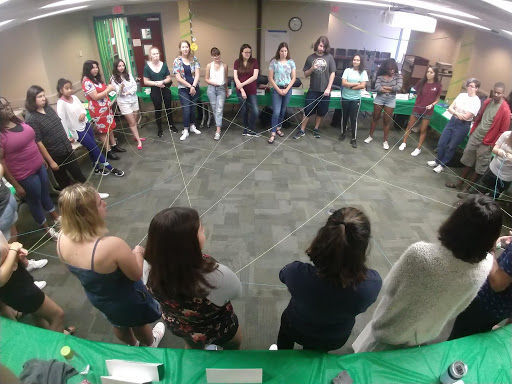Departments across Trinity worked over the summer to make New Student Orientation (NSO) happen, contributing food, Trinity gear and space on campus. This means budgets can collide.
NSO consists of a weekend full of events for incoming students to get to know Trinity’s campus, traditions, faculty, staff and their peers. It’s filled with food, promotional items and lots of presentations. Esther Kim, assistant director for orientation programs, is awarded a yearly budget to promote and carry out NSO, Spring Student Orientation, Orientation Team (O-Team) and spirit initiatives.
“We provide critical academic sessions on how to be successful at Trinity while also providing them opportunities to be engaged on and off campus with the Student Involvement Fair or the Campus Service Project,” Kim wrote in an email interview.
Although Kim cannot disclose the budget, the biggest expenses of NSO are food, supplies and marketing. Meals and snacks are provided at various events, including the community luncheons for underrepresented groups on campus, such as black, Latinx, international and first-generation students.
Kim’s budget also finances supply rentals and purchases like tables, chairs and campus maps for students and family. Additionally, the budget funds marketing initiatives from her department.
However, other facets of NSO don’t require money from Kim’s budget. Volunteers contribute their time to events allowing Kim to distribute that money elsewhere. Team Trinity is made up of student and faculty volunteers that help move first years into their residence halls. O-Team, after a week-long training session with Kim, works to make first-years feel welcomed and connected to the Trinity community.
Additionally, many departments on campus contribute to New Student Orientation.
“Every department and office on campus contributes to NSO in some way from space, sponsored food [that the budget does not pay for] from Aramark, [Residential Assistant] staff, volunteers, Team Trinity etc. It’s an all hands on deck approach when it comes to NSO,” Kim wrote.
Departments on campus do not directly contribute money from their own budgets. Rather, they contribute items or spaces to NSO. Tess Coody-Anders, vice president for strategic communications and marketing, uses about one-third of the department budget to support events and efforts related to admissions, including NSO. For example, instead of Kim using her budget to buy promotional materials, the strategic communications and marketing department will collaborate with her to contribute promotional items to NSO.
“We just work together and collaborate. Let’s say, for example, she wanted to buy a plastic water bottle. Well, no need for [Kim] to go buy them, and we’re buying them for future students. Let’s work together so we can get a better price,” Coody-Anders said.
Additionally, Coody-Anders’ creative team contributes expertise and ideas to NSO when thinking about ways to create a cohesive Trinity brand for events during Welcome Week.
“Our role is to make sure the brand message and the graphic standards are always being adhered to for the university so that we’re consistent,” Coody-Anders said. “So that even if you might have your own marketing person and your own marketing budget, that we all sing from the same song sheet — and that we look the same and we don’t confuse people by presenting a different image or message about Trinity.”
When new initiatives are added to NSO, like the community luncheons last year, they are not included in Kim’s budget. Instead, departments contribute elements to it. Sheryl Tynes, vice president for student life, works with Kim on New Student Orientation and spoke about how Kim’s budget grows.
“If we have a new initiative that’s not in the budget, we request other university offices to contribute. It’s not really a donation, it’s like do you have some budget, so you can help with this new initiative?” Tynes said.
After this process, if the initiative receives positive reviews from students, it is included in Kim’s budget for the next year.
Overall, Tynes believes that NSO takes a lot of effort because it is critical to a new student’s transition to Trinity University.
“The whole goal of new student orientation is to help start the process of creating a sense of belonging for our students and to connect faces with names. And so here are the people, here are their names, here are ways you can reach them and sort of make that human connection, which is what small liberal arts schools do way better than a big school could do,” Tynes said.







